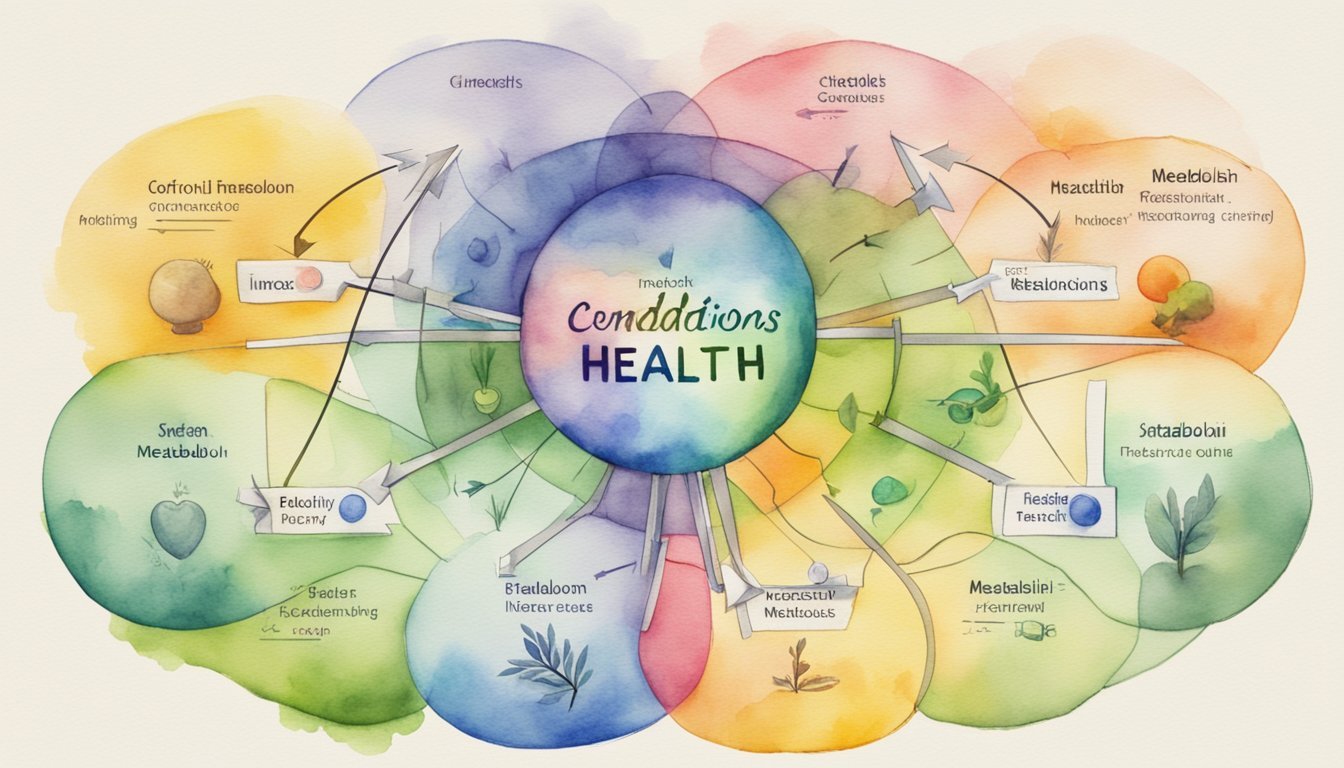Understanding Metabolism
Metabolism involves complex chemical processes that keep our bodies alive and functioning. At its core, metabolism converts the fuel from our food into the energy we need to power everything from moving to thinking to growing.
Basal metabolic rate (BMR) is the amount of energy expended while at rest in a neutrally temperate environment. This accounts for the largest portion of a person’s total caloric needs. Factors influencing BMR include body size and muscle mass—the larger you are, or the more muscle you have, the more calories you burn at rest.
Similar to BMR, the resting metabolic rate (RMR) approximates the number of calories one’s body requires to maintain basic physiological functions like blood flow and breathing. Still, resting energy expenditure is a slightly broader term, including the energy needed for digestion on top of RMR.
Body composition plays a significant role. Bodies with a higher ratio of lean muscle burn more calories even at rest, a principle known as thermogenesis. Exercise, particularly strength training, can boost this effect by increasing muscle mass.
Different tissues in our body contribute to our overall metabolic rate. Muscular tissue requires more energy than fatty tissue. Thus, increasing muscle mass typically boosts metabolic rate, while fat oxidation refers to the breakdown of fat for energy, another vital piece of the metabolic puzzle.
The food we consume can also affect our metabolism. Meals trigger a rise in metabolism as the body works to process and absorb nutrients, an effect known as the thermic effect of food.
Remember, while one can influence their metabolism to some degree, some aspects, like body size and body composition, are significantly impacted by genetics and overall health.
Optimizing Diet for Metabolic Health

A well-structured diet plays a crucial role in boosting metabolic health, focusing on balancing macronutrients, meal timing, and understanding the thermic effect of food.
Balancing Macronutrients
Balancing the intake of macronutrients—protein, carbohydrates, and fats—is essential for a well-functioning metabolism. Proteins are particularly noteworthy, as they are the building blocks of muscle and can increase caloric burn due to their high thermic effect. Incorporating lean proteins like chicken, fish, or plant-based options can aid in metabolism efficiency. Carbohydrates should come primarily from complex sources like whole grains, offering sustained energy and fiber. Healthy fats from sources such as avocados and nuts are crucial for absorption of fat-soluble vitamins and provide necessary lipids for the body.
Timing and Frequency of Meals
The debate on meal timing and frequency continues, but strategic eating schedules can potentially help maintain a steady metabolic rate. Consuming smaller, nutrient-dense meals more frequently throughout the day may prevent metabolism from slowing down and stabilize blood sugar levels. However, it’s also important not to consume calories in excess of daily needs. Calorie deficit diets should be approached cautiously to avoid metabolic slowdown.
Thermic Effect of Food
Certain foods can increase metabolic rate through the thermic effect of food (TEF), which is the energy required for digestion, absorption, and disposal of the nutrients. Protein has the highest thermic effect, followed by carbohydrates and fats, meaning that calories from protein-rich foods burn more energy during digestion. Spices like capsaicin in chili peppers, caffeine in coffee, and the compounds in green tea and oolong tea can also enhance metabolism. These dietary components work synergistically to increase overall energy expenditure.
Impact of Physical Activity

Physical activity is not just about burning calories; it’s also a powerful way to rev up your metabolism. Regular movement transforms your body into a more efficient energy-burning machine.
Types of Exercise
Exercise can be categorized into aerobic (or cardio) and anaerobic, involving resistance training and strength training. Aerobic exercises, like jogging or swimming, improve your cardiovascular health and burn calories. On the other hand, anaerobic exercises, such as weightlifting, enhance muscle mass and consequently boost basal metabolic rate (BMR).
Building Muscle to Boost Metabolism
Muscle tissue burns more calories at rest than fat does. Incorporating strength training into your routine can increase lean muscle, effectively raising your BMR. Even after a strength workout, your body continues to consume more oxygen, thus increasing post-exercise energy expenditure.
The Role of High-Intensity Interval Training
High-Intensity Interval Training (HIIT), which alternates between short bursts of intense activity and periods of less intensive movement or rest, is notable for its calorie-burning efficiency. HIIT has been shown to improve fat metabolism, reduce body fat, and may have a beneficial impact on blood pressure.
Lifestyle Factors Influencing Metabolism

Our metabolism is as unique as a fingerprint — several factors contribute to its pace, including ones we can control through a healthy lifestyle. Let’s explore how sleep, daily activity, and stress management can rev our metabolic engines.
Sleep Quality and Metabolism
Proper sleep hygiene plays a critical role in regulating one’s metabolic rate. A good night’s sleep helps balance hormones like insulin and cortisol that affect how our body uses glucose and stores fat. Individuals aiming for metabolic efficiency should prioritize sleep quality, as it influences the burning of calories and management of cholesterol levels.
Sitting, Standing, and NEAT
NEAT, or Non-Exercise Activity Thermogenesis, refers to the energy expended for everything we do that is not sleeping, eating, or sports-like exercise. It can range from sitting to standing, and even fidgeting. Keeping muscle mass engaged through regular movement, like standing up every hour or taking the stairs, can boost your metabolic rate significantly as more calories are being burned even outside of dedicated workout times.
Stress and Hormonal Balance
When we’re stressed, our bodies release cortisol, a hormone that can lead to increased blood pressure and fat storage. Managing stress through relaxation techniques and hobbies can help maintain hormonal balance, which in turn supports a healthy metabolic rate. High stress levels can also influence blood sugar levels and triglycerides, so keeping stress in check is not just good for the mind, but great for the metabolism as well.
Health Conditions and Metabolism

The link between health conditions and metabolism is complex, often involving factors like obesity, thyroid function, and genetics. How your body converts food into energy can significantly affect weight management and overall health status.
Metabolic Impact of Obesity
Obesity is not just about carrying extra weight; it’s a health condition that can significantly slow down metabolism. Excessive body fat, especially around the waist, can lead to a reduced metabolic rate, making weight loss challenging. It contributes to signs of a slow metabolism, such as fatigue and muscle loss, which might make it difficult to stay active and further exacerbate obesity’s effects.
Thyroid Function and Metabolism
The thyroid plays a pivotal role in regulating metabolism through the production of hormones. Hypothyroidism, or an underactive thyroid, can lead to a slow metabolism, weight gain, and feelings of tiredness. Thyroid disorders, if left untreated, can disrupt metabolism and contribute to obesity and diabetes. Monitoring thyroid function is crucial for maintaining a healthy metabolism.
Role of Genetics and Age
Genetics and age heavily influence one’s metabolism. Certain genetic factors predispose individuals to a faster or slower metabolism, affecting weight management throughout their lives. As people age, muscle mass naturally decreases and metabolism slows down. Understanding these factors can provide insight into personalized approaches for weight loss or weight management, accounting for the diverse needs of individuals based on their genetic makeup and age.

